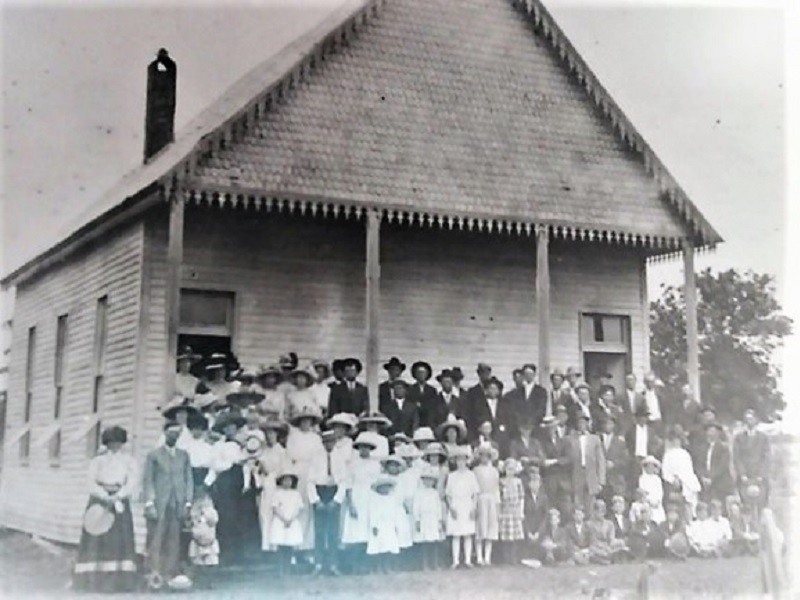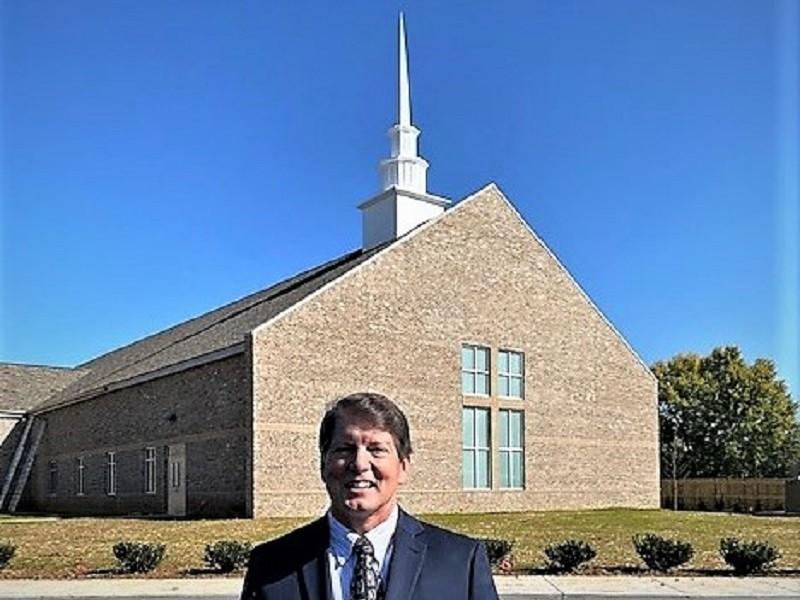(MURFREESBORO) This coming Sunday is a dream comes true for the congregation at Barfield Baptist Church. Pastor Ron Ryers announced that their first service will take place at 10:30AM in the new sanctuary at 550 Veterans Parkway, across from Barfield-Crescent Park.
For those who are not members of the local congregation, you have heard about them many times on WGNS telling about their Grief Support sessions.
History of the Church
The faithful husband and wife team of Robert and Camilla Jamison were there, as was the widow Nancy Gamewell and her children. They met, along with Ellen McCullough and two ministers of the Lord, under a large oak tree near where the old Barfield Post Office once stood, and on the morning of September 8, 1898, with an act of simple faith beneath the watchful eyes of God, established Barfield Baptist Church.
God has used many diverse individuals to carry on this ministry throughout its long history. For example, in the days of the Depression, deacon and treasurer Houston Lovvern went out on horseback Saturday mornings to collect enough coins to pay the pastor on Sunday. In August of 1945, as the atom bombs put an end to WW2, a very young girl named Rachel Lovvern joined Barfield Baptist Church; she is still a member and a Sunday School teacher today! Joyce Helton has also been faithfully serving in the church for 65 years!
Deacon Alex Briley served from 1932 to 1978, and has left behind many colorful memories of his activities at the church. Bobby Douglas, a deacon for decades, joined in 1958 and still attends with his wife Louise.
Barfield Baptist has changed with the times, but it remains a church where God and his principles are still honored. While the once common image of the hardworking Barfield farmers, with wives and children, making their way, on foot or by horse and buggy, to the one-room wooden church building, has obviously undergone a big transformation, the gospel message has not been altered!
Barfield Baptist has had over thirty pastors, all preaching the same message about the old rugged cross, where the greatest act of love unfolded; where the price for the sins of mankind was paid - not by mankind, but by Jesus Christ and his love.
Pastors like Wayne Tarplay, Leonard Arbuckle, and Greely Davenport have been greatly used of God. Brother Ron Byers, current pastor since 1998, keeps the focus where it ought to be: on the Scriptures, on the Lord Jesus Christ, and on the whole spiritual process of the church “edifying itself in love” (Eph.4:16). Brother Ron has fostered an atmosphere where individuals are free to use the gifts which God has given them. As it grows and moves into a new facility, we fully expect Barfield Baptist will always be a place where the gospel of the grace of God is not compromised, and where the saints are encouraged and comforted in the fellowship of the Spirit and in the Truth of the Scriptures.
Treasures Found
There was a filing cabinet at Barfield Baptist Church. It was your standard beige-colored, 5 drawer metal cabinet, which, like bland scenery in any church or office, drew no attention to itself; and while it was locked and keyless for years, it served no purpose in the daily life and administration of the church. Except – it was storing a treasure!
Intrigue into its contents was aroused when the Archive Committee was formed in 2018.
When it was busted into, the greatest hopes of the curious were realized: archival records in the form of membership logs and minute books from the very beginning of the church’s existence!
From these and other sources, the history of the founding of Barfield Baptist Church can be pieced together and presented in story form, so our roots are not forgotten; so this present generation may draw inspiration from those who have labored in the Lord before us, and so we can feel connected, through this research, with those whose passions and ministries we carry on.
Barfield Community
It’s not a city or a town. For two hundred years, since its namesake bought and sold in the land until now, it has maintained the designation of ‘a community’. Fredrick Barfield did much to warrant the identification of his name with this place, but he was born too early to warrant a place in the story of the church which bears his name.
William Henry Campbell, on the other hand, was still in his prime when the church was founded. Twenty seven years and eleven months after he was born, he was born again – not for the second time from his mother’s womb as Nicodemus once pondered, but like Jesus explained it: by the Holy Spirit of God!
That was in February, 1898; another precious soul crossed the aisle, delivered from the power of darkness, according to Col.1:13, and translated into the kingdom of Jesus Christ. In heaven, “there was joy among the angels of God”, (Luke 15:10). In Barfield, William became part of the “little band”, as G.A. Ogle of the Baptist and Reflector publication described them.1 They were the Baptists of Barfield. It was about twenty five years before the term “Bible belt” was coined, but there they were in the middle of the state of Tennessee, set on anchoring their Christian faith upon nothing less than the inspired Words of the Holy Bible.
Truth be told, there were more Methodists in Barfield at that time than Baptists, and they had their own church too. In fact, it still stands today: the Farris Chapel United Methodist Church. Its present address is 2914 Barfield Road, but when it was constructed in 1880, they just called it the “Murfreesboro and Shelbyville dirt road”.
The Methodist church was originally set up as a “Union Church”. Although the Methodists were the ‘keepers of the house’, it could be shared with other denominations when not in use by the Methodists. (It also served as a public school until a separate schoolhouse was built in 1893.) No doubt at least some of the neighborhood Baptists met there from time to time, but if the “little band” desired membership in a legitimate Baptist church with its own pastor and deacons, etc., their nearest option was six miles away in the city of Murfreesboro, where the First Baptist Church had been serving the community since 1843. In those days of horse and buggy travel upon unpaved roads, the idea of a neighborhood church must have been very appealing.
In the vicinity of the Methodist church, in what one might call the ‘hub of Barfield’, there was a general store, a blacksmith shop, the schoolhouse, and a post office. Beyond that Barfield was farm country. There were horses and ploughs, chickens and livestock, and fields of crops such as corn and wheat and cotton. It was old-fashioned, rural America all the way: farms, families and faith.
The West Fork of Stones River did nothing to detract from the scenic landscape of the area, as it brushed the edge of the ‘the hub’ with its west bank. Although not a long river or a mighty one, Stones River is well known for the New Year’s skirmish, 1863, when young men from the north and south squared off in a confrontation which left nearly 3,000 dead soldiers and about 7 times that many wounded and captured or missing.
William Thomas Gamewell was a Confederate soldier who survived the battle of Stones River - a few other battles as well, and a captivity - allowing him to keep his promise. Prior to the river battle, he and a contingent of fellow soldiers were camped out on a farm in Norene, TN., just northeast of Murfreesboro. On this farm lived “a beautiful southern young lady, light brown wavy hair and sky-blue eyes – a very petite girl with a lovely figure.” Her name was Nancy Lavinia Hill. She and ‘Billy’ fell in love over the span of a couple weeks, and before he set out for the big battle, he promised her, “when the terrible war was over that he would return and claim her for his bride.”
They married on October 21, 1868. Six children later, they purchased 140 acres of farmland in Barfield, on the east bank of Stones River, across from ‘the hub’, and about seven miles upstream from where William fought 21 years earlier. There they had two more children: twins, Robert and Etta. Twenty months later, on December 14, 1887, William died at the age of 48, and Nancy Gamewell became a widow with eight children at 41 years of age.
At some point, Nancy and her children joined the Baptist church in Murfreesboro where another family from Barfield was already serving. Robert D. Jamison and his wife Camilla were married on the eve of the Civil war, during which, Robert served in the Confederate Army, and after which, they served the Lord Jesus together, mostly at First Baptist Church of Murfreesboro where Robert was a deacon and a church clerk. They owned a farm in Barfield about one mile south of the ‘hub’.
1898: A Church is Born

It did not take William Campbell long to catch the vision of a Baptist church in Barfield. By September, 1898, there was “a spot of land that had been given to the Baptists on which to build a church”, wrote William Wood, a minister and charter member of the church.4 Evidently, William Campbell was the giver of the land – or at least, at that point, the promisor of the land.
Thursday, September 8, 1898, was day one in the history of Barfield Baptist Church. It was a pleasant day in Middle Tennessee: dry and comfortable, with a high temperature of 76 degrees. According to William Woods’ article in the Baptist and Reflector, he, another minister, and six believers spent that day establishing, organizing, and growing the new local ministry. They met together at 10:00 A.M., had song and prayer, and then, for the official creation of the church, moved onto the very plot of land promised ahead of time - the promised land, if you will. There, “under a large oak tree near the Barfield post office”, the church was born! “Letters were called for and read by the clerk. Six came forward and resolved themselves into a church”.
The clerk who read the letters was William Woods. The six primary charter members were Nancy Gamewell, now 52 and still a widow, two of her children: Otis, age 28, and Laleyer, his 15 year old sister, Robert and Camilla Jamison, and a Mrs. Ellen McCullough.
Interestingly, the Gamewell’s and the Jamison’s were able to transfer their membership to the new congregation in Barfield without changing pastors! The other minister with the group that day was brother Isham Anderson Hailey; he was pastor of First Baptist of Murfreesboro from April, 1895 until the end of 1899. He assisted the Barfield believers in organizing their new church, and remained with them for about a year afterwards. He is counted as the founding pastor of Barfield Baptist. It was not unusual in those days for a pastor to have commitments to more than one church at the same time.
These six believers, already grounded in the faith and serving in other churches, together with brother Woods and brother Hailey, constituted the nucleus of Barfield Baptist Church. Otis Gamewell was appointed to be the church clerk, and Robert Jamison was the church’s first deacon. There were four others, new believers not yet baptized, waiting in the wings, or presumably, in the shadows of the oak tree, who joined the church immediately. “The doors of the church were opened,” brother Woods continued in his article, “Four came forward for membership and were received.”
Barfield Baptist’s own church archives mirror his account exactly, showing the six and William Woods who came by letter and were listed as “Members in the organization”, followed by four names of those who were “Members received” on the same day but needing baptism. The first name on the list of four is William Campbell! He is followed by Ernest McCullough, Maude McCullough, and Laura Morton.
Two more joined later that day “on promise of procuring letters from the church to which they belonged”. They were Mr. and Mrs. William H. Womack. The following day, Friday the 9th, a Miss Callie Evetts and a Mrs. John Ogle “were received by experience when baptized”. Those two, along with the four above, did not have to wait long to be baptized, nor travel far. On Sunday the 11th, there was a baptismal service down by the river, on the western border of the Gamewell farm.
September 11, 1898 was a spectacular day. The waning summer turned it up a little from the previous Thursday, and the afternoon temperature leveled off at 82 degrees – perfect for outdoor baptisms! One can just imagine the exceptionally picturesque landscape, and the spirit of Christian fellowship, coming together. Nature’s beauty divinely supported the spiritual celebration of eternal life as pastor Hailey baptized the above named six new believers in the faith, along with an even more recent joinee, Mrs. A. Davis. They publicly identified with the death, burial, and resurrection of Jesus Christ in the waters of Stones River. It was a meaningful and joyous way to round out the first weekend in the history of Barfield Baptist Church!
By Tuesday night, five more of Barfield’s faithful joined the new body of believers. Sunday night, K.P. Johns and wife Fannie Johns joined by letter from North Fork Baptist Church, Bedford County. Monday night James Barber was received on promise of securing a letter from church as soon as possible. Tuesday night, Miss Lee Cook and John W. McCullough were received by experience. Shortly thereafter, eight others joined, including two more daughters of Nancy Gamewell: Mary, age 24, and Lavinia Belle who was 13 or 14 years old.
Before moving on, here are two quick observations. First, concerning the oak tree, a couple Bible passages come to mind. In Old Testament times, Gideon’s powerful ministry began “under an oak” (Judges 6:11). Before him was Joshua, who, upon hearing the children of Israel echo his memorable words, “As for me and my house, we will serve the Lord”, took a great stone and set it under an oak tree as a testimony to God’s words and to the people’s oath to serve him (Joshua 24:15-27).
Were the Barfield believers motivated by these Bible passages when they chose their meeting place? There were pledges made, like in Joshua’s time, and a new ministry begun, as with Gideon – so who knows? Maybe they were!
Second, concerning the river: it was the church’s baptismal place for a long time to come, for it was three and a half years before Barfield Baptist had its own church building, and not until 1976 was it fitted with a baptistery! As of this writing, five current members who joined prior to ’76, were baptized in the river: Rachel Morton in 1945, Joyce Helton in 1955, Bobby Douglas in 1958, Becky Haynes in 1967, and Steve Helton in 1970.
The First Few Years
There was no pomp or publicity – just an act of simple faith beneath the watchful eyes of God - and the Barfield farmers had a church of their own, but the church had no property and no building. Furthermore, the church itself left no record of how it acquired either one. After those memorable September days of 1898, the church archives fall silent for the next three and a half years. (Actually, the record book begins in May, 1902 with the dedication of the new building, but the details of that first week which Otis Gamewell recorded somewhere, were recopied into the new book by the second church clerk, R.D. Jamison.)
In absence of church documents, lets fill in this three and a half year gap as best we can. On April 14, 1963, the Daily News Journal ran a series of articles containing brief histories of Baptist churches in the Concord Association. In the article dedicated to the Barfield church, we’re told, “These people continued to meet in the Union Church Building with Rev. I.A. Hailey preaching for them one Sunday each month.” The monthly meetings at the Union Church lasted until the new building was ready, but pastor Hailey could not stay that long. Barfield welcomed its second pastor, Calvin S. Dillon, somewhere during this time, and it is not difficult to pinpoint the date. Brother Jamison recorded in the minutes from February 1, 1903 that pastor Dillon completed “three years of faithful service”. That would put the commencement of his service in January, 1900, which corresponds with the time pastor Hailey resigned from First Baptist of Murfreesboro. It makes sense that he stepped aside from Barfield at the same time seeing as how he left Tennessee altogether and “served churches at Clinton, Kentucky and at Mount Olive and Meridian, Mississippi.”
So the new century brought a new pastor to Barfield. Also in the year 1900, as per the same 1963 DNJ article, the church then “secured property at the corner of Midland and Barfield Road, and began constructing a building.” According to the Rutherford County Register of Deeds, the transfer of land was in August, but it did not come from William Campbell. In February, William Campbell and his wife Nettie (they also had two small boys), sold 135 acres to another young couple, Mr. and Mrs. James Bell, who, from this acquisition, donated half an acre to Barfield Baptist in August.
Did William Campbell know, when he sold his land, that he only had a short time to live? He became ill or injured – we do not know which, or for how long – but he died on July 16, 1900. According D.B. Vance, of the Baptist and Reflector, William was “a model man, a consistent Christian, devoted and loving husband and father. He died in the triumphs of a living faith.”
The deed on file at the Rutherford County Register of Deeds gives August 15, one month after William’s death, as the date when James Bell and wife transferred the land to the church. His donation was motivated by “the love and goodwill I entertain” for the church. This lot was on the west side of Stones River, opposite from the Gamewell farm, and just 300 yards from the Methodist Church. Immediately, revival meetings were held! Exactly eight days later, on August 23, G.A. Ogle wrote in the Baptist and Reflector:
“I am just out of a good meeting of eight days held at Barfield in the tent owned and controlled by the Concord Association, and under the immediate direction of Bro. C.S. Dillon. Great crowds attended the meetings, and many non-church-goers were greatly benefitted . . . Several Baptists have gathered themselves together here . . . They have started a subscription and appointed a building committee, and I predict that within a short while a house will be built. With Bro. Dillon as a leader, and Bro. Jamison and Dr. Knox and others at his side, we shall expect great things from this place.”
Robert Jamison, who in addition to being a Civil War vet and a Barfield farmer, was also president and professor of languages and book-keeping at Union University high school in Murfreesboro during the 1880s, said of the Barfield church in January, 1901: “. . . they are within about $100 of completing the house of worship. The members of the church and their friends and neighbors have worked very heroically to build the church. If anyone should find it in their heart to render any assistance it would be thankfully received.”20
The date of the completion of the building is not documented. The dedication service was originally planned for March 30, 1902, but was postponed until May 4, 1902. (There was a Fifth Sunday Concord Association meeting held in the building on March 28, 1902.)
All the waiting and all the hard work were worth it: “May 4, 1902 dawned bright and lovely, and was most propitious for the dedication,” wrote Bro. Jamison in the new church minute book, “A large crowd was assembled on time. Several ministers were present and took part in the service.”
Minister and charter member William Woods, who left the church by letter sometime in 1901, probably to minister at another church, returned on this day and “made a good prayer” during the service. Visiting minister J.C. Midyett, who preached the sermon from Jude vs.3, “Contend Earnestly for the Faith”, described the building as “a neat, comfortable house of worship, which cost about $700.” He also noted, “The church has a live Sunday School, and the whole enterprise seems to have the smile of the Father upon it. There are some noble saints at that place and we expect large things from it.”
All we know is this classic, priceless picture was found one day in a closet in the church by Joyce Helton. She rescued it and had it fitted into a nice frame. It has hung in our church lobby ever since, and will be on display again when our new church building is dedicated.
Epilogue
Barfield Baptist has known some good times; it has lived through bad times too. Some kind of God-sponsored resilience has kept it alive whenever it has found itself in a valley. At the start, those three years of pastor Dillon’s “faithful service”, were “under very trying circumstances,” and it was just the beginning. It was a new century – the 60th since God created man, and the 20th since He became one. Ahead lie not just typical internal struggles of a small country church (like, for example, how to scrape up enough coins to pay the pastor each month), but world affairs from which not even a community like Barfield could claim immunity: a world war, the great depression, another world war, rebellion and protest among the youth, and strong cultural trends away from Biblical Truth and traditional values.
Barfield Baptist has changed with the times, but not with the culture. The once common image of the hardworking Barfield farmers, with wives and children, making their way, on foot or by horse and buggy, to the one-room wooden church building, has obviously undergone a transformation. But the gospel message has not been altered one iota!
Barfield Baptist has had over thirty pastors, all preaching the same message about the old rugged cross, where the greatest act of love unfolded; where the price for the sins of mankind was paid - not by mankind, but by Jesus Christ who himself never sinned.
Brother Ron Byers, current pastor since 1998, keeps the focus where it ought to be: on the Scriptures, on the Lord Jesus Christ, and on the whole spiritual process of the church “edifying itself in love” (Eph.4:16). It is currently stronger than ever in terms of numbers and finances. As it grows and moves into a new facility, may Barfield Baptist never forget its roots nor leave its first love; may it always be a place where the gospel of the grace of God is not compromised, and where the saints are encouraged and comforted in the bond of the Spirit and in the Truth of the Scriptures.
A Brief Follow-up
Two families were instrumental in the founding and establishment of Barfield Baptist church: the Jamison’s and the Gamewell’s.
Robert and Camilla Jamison were a devoted husband and wife team in their service for the Lord Jesus. To quote another Baptist and Reflector article: “two of the most consecrated Christians that we know”. They were remembered at First Baptist Murfeesboro as always attending every service, with all their six children, even after they moved further away to Barfield. Robert wore many hats in his labors at First Baptist Murfreesboro and Barfield Baptist. “He was one of the best pastor’s helpers we ever knew,” it was noted in his obituary. He died on August 12, 1912 at the age of 74. Camilla, who preceded Robert in death, was praised for her faithfulness and cheerfulness. One paragraph in her obituary states: “Perhaps the best work of her life along religious lines was done at Barfield, near Murfreesboro, in the last ten years. She was known as the mother of the church which grew from 6 to 40 members.” She went to be with the Lord on July 11, 1908. They are both buried in Evergreen cemetery in Murfreesboro.
On Sunday, June 17, 1923, Barfield Baptist church had a visitor from Nashville. He was Harry D. Jamison, son of Robert and Camilla. He presented to the church a silver communion set which the church has kept and displayed for almost 100 years now. The bottom of the chalice has the engraved words: “In memory of Mr. & Mrs. R.D. Jamison.”
The contributions of the Gamewell family to Barfield Baptist Church persisted through the years. Two more children joined in July, 1904: son Hugh, and Etta the girl twin. In 1910, two more of Nancy's sons - Robert the boy twin and William Early, purchased from the same Mr. and Mrs. Bell, the same 135 acres of land which William Campbell sold them. Then in 1919, these two brothers donated another a half-acre to the church. Since neither of them were members, one might wonder: what motivated them to do this? The answer can be found in the text of the deed of transaction filed in the Rutherford Co. Register of Deeds Office:
“For and in consideration of the love and affection that we have for our mother, Mrs. N. L. Gamewell, who is a devoted and enthusiastic member of the Missionary Baptist Church, and knowing that this action by us will be highly appreciated by her; We, R.L. Gamewell and W.E. Gamewell, have this day bargained and sold and do hereby transfer and convey to the Board of Deacons of the Barfield Missionary Baptist Church . . . “
They did it to honor and please their mother.
Nancy Gamewell never remarried; she remained committed to her family and her church unto the end. Two years after this kind gesture by her sons, that is, on July 7, 1921, five days short of her 75th birthday, Jesus took her to her new home in the glorious, eternal heaven!
The deed of 1919 contains a stipulation “that if the property herein conveyed ceases to be used and occupied as church property, by the Barfield Missionary Baptist Church, then in that event the said property is to revert to the undersigned, or to their heirs.”
This is pointed out here just to bring us to the next act of generosity by a member of the Gamewell family. One of the heirs who came to own the property was Robert's son, Dr. Robert Gamewell Jr. (The bridge where Veterans Parkway crosses over Stone's River today is named after him.) In 2002, when Barfield Baptist needed to expand its facility, he and his wife Kitty donated yet more land to the church, AND, officially released the restriction binding upon the church and the land for the previous 83 years! This, according to his daughter Aleta Gamewell Tuma, was very important to him; something he felt compelled in his heart to do for the church. This also is something which Barfield Baptist is extremely grateful for today because, as of this writing, the present church building is sold and a larger facility is being constructed about one mile up Veterans Parkway, across from Barfield Crescent Park.
God is the foundation of Barfield Baptist church. He is the heartbeat of its history. He has used many “noble saints”, past and present, to keep His Word alive in the Barfield community. May He, and His Truth, continue to be the foundation and the heartbeat of this ministry unto the end!
“Praise ye the LORD. Praise God in his sanctuary: praise him in the firmament of his power.” Psalm 150:1





